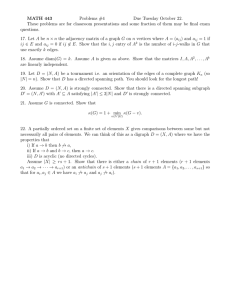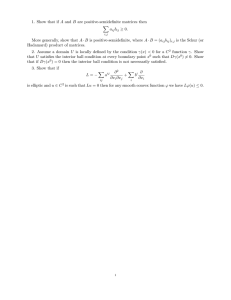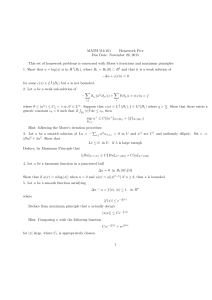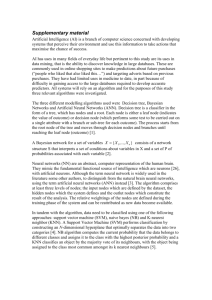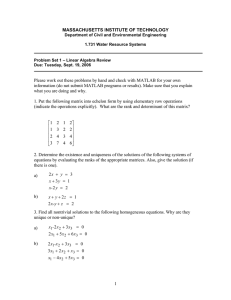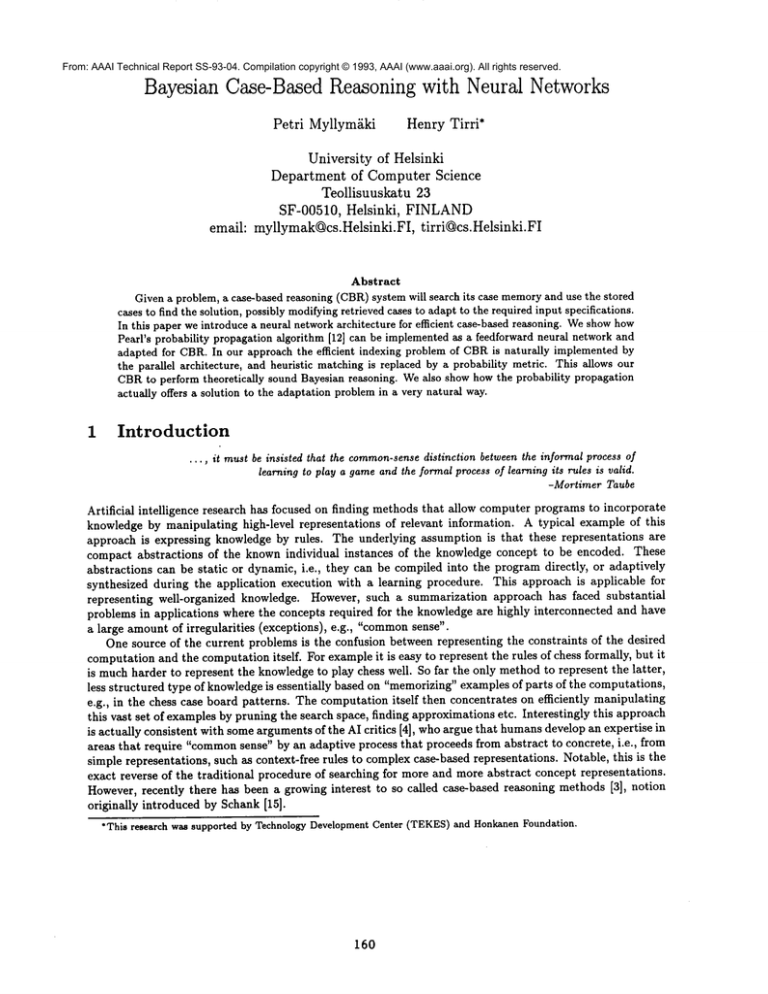
From: AAAI Technical Report SS-93-04. Compilation copyright © 1993, AAAI (www.aaai.org). All rights reserved.
Bayesian Case-BasedReasoningwith Neural Networks
Petri Myllymgki
Henry Tirri*
University of Helsinki
Departmentof ComputerScience
Teollisuuskatu 23
SF-00510, Helsinki, FINLAND
email: myllymak@cs.Helsinki.FI,
tirri@cs.Helsinki.FI
Abstract
Given a problem, a case-based reasoning (CBR)system will search its case memoryand use the stored
cases to find the solution, possibly modifying retrieved cases to adapt to the required input specifications.
In this paper we introduce a neural network architecture for efficient case-based reasoning. Weshow how
Pearl’s probability propagation algorithm [12] can be implemented as a feedforward neural network and
adapted for CBR. In our approach the efficient indexing problem of CBRis naturally implemented by
the parallel architecture, and heuristic matching is replaced by a probability metric. This allows our
CBRto perform theoretically
sound Bayesian reasoning. We also show how the probability propagation
actually offers a solution to the adaptation problem in a very natural way.
1
Introduction
...,
it must be insisted that the common-sensedistinction between the informal process of
learning to play a gameand the formal process of learning its rules is valid.
-Mortimer Taube
Artificial
intelligence
research has focused on finding methods that allow computer programs to incorporate
knowledge by manipulating high-level representations
of relevant information. A typical example of this
approach is expressing knowledge by rules. The underlying assumption is that these representations
are
compact abstractions
of the known individual instances
of the knowledge concept to be encoded. These
abstractions
can be static or dynamic, i.e.,
they can be compiled into the program directly,
or adaptively
synthesized during the application execution with a learning procedure. This approach is applicable for
representing
well-organized
knowledge. However, such a summarization approach has faced substantial
problems in applications
where the concepts required for the knowledge are highly interconnected and have
a large amount of irregularities
(exceptions), e.g., "commonsense".
One source of the current problems is the confusion between representing the constraints of the desired
computation and the computation itself. For example it is easy to represent the rules of chess formally, but it
is much harder to represent the knowledge to play chess well. So far the only method to represent the latter,
less structured type of knowledge is essentially based on "memorizing" examples of parts of the computations,
e.g., in the chess case board patterns. The computation itself then concentrates on efficiently
manipulating
this vast set of examples by pruning the search space, finding approximations etc. Interestingly
this approach
is actually consistent with some arguments of the AI critics [4], who argue that humans develop an expertise in
areas that require "commonsense" by an adaptive process that proceeds from abstract to concrete, i.e., from
simple representations,
such as context-free rules to complex case-based representations.
Notable, this is the
exact reverse of the traditional
procedure of searching for more and more abstract concept representations.
However, recently there has been a growing interest
to so called case-based reasoning methods [3], notion
originally introduced by Schank [15].
*This research was supported by Technology DevelopmentCenter (TEKES)and HonkanenFoundation.
160
Teaching mode
Query mode
daptt
Case
Matcher
Chooser
User Interface
Case
Adaptor
[
Figure 1: CBRsystem architecture
In case-based reasoning (CBR) paradigm the dynamic case memoryis central to the reasoning process
(see the process modelin Figure 1) -- learning is an inherent part of the process. Althoughthe idea of using
a case memoryis simple in principle, there are manydifficult problems related to case indexing, similarity
metric in case matching and case adaptation. For example much of the published work has concentrated
on applying machine learning methods for indexing cases in order to avoid costly comparison of the input
with the large set of cases in the case memory.Similarly developing appropriate metric for matching has
in practice lead to heuristic solutions which are hard to justify theoretically. In this paper we discuss the
use of feedforward neural networks to implement a case based reasoning system with a probability metric,
which allows us to do theoretically sound Bayesian reasoning. Consequently we propose solutions to three of
the problems in case based reasoning: case indexing (by the parallel neural architecture), case matching (by
probability metric) and case adaptation (by propagating probabilistic information back to the input vector).
2
Case-Based
Reasoning
and Neural Networks
During the past few years a rediscovered computational paradigm of neural computing has spawned a
large amount of research activities [1, 6, 14]. Muchof the excitement surrounding this approach has been
inspired by the rich possibilities inherent in ideas of distributed representation of knowledge, reasoning
based on constraint satisfaction, and neurally-realistic cognitive modeling. As connectionism has challenged
the physical symbol system modelingof traditional artificial intelligence, there is an ongoing debate of the
respective roles of these two approaches in explaining intelligence [13, 16]. However,in spite of the debate
there are clear connections between both of the approaches. Case-based reasoning is one of the areas where
one can combine the ideas from these apparently diverse approaches fruitfully.
What is the appeal in neural networks for case-based reasoning? First of all neural networks are constructed from a large amountof elements with an input fan order of magnitudes larger than in computational
elements of conventional architectures. This means that they can be used for distortion tolerant storing of
a large number of cases (represented by high dimensional vectors) by making single elements "sensitive"
to a stored item, i.e., to produce a high output for particular subregions in the input space. Hence neural
computing models offer an ideal architectural frameworkfor the methods in case-based reasoning, which are
based on using a set of high-dimensional cases stored in a knowledgebase. Secondly, as there is nothing
161
that resembles a shared memory,the neural computing architecture is inherently parallel, and each element
can perform comparison of its input against the value stored in the interconnections independently from
the others. This offers a linear speed-up in the comparison process with respect to the number of computational elements available. The case indexing problem is thus addressed directly at the architectural level
where matching can be performed by using the available parallelism. This kind of a memory-basedreasoning
approach allows matchingof the input against millions of stored cases efficiently [7].
In addition, as in manysituations the result of the individual comparisons can be mergedto achieve a
lower dimensional output, such as a binary decision, the resulting computingstructure is fault-tolerant as
loss of a single element (case) does not in general have a great effect on the overall result. Consequently
neural computingmodels offer an architecture that, at least in principle, matches already in its structure
manyof the requirements needed for representing case memory:efficient storing of cases and fast mechanisms
for comparing high-dimensional patterns with tolerance for input distortions. On the other hand, neural
architectures do not offer directly solutions to the problem of choosing proper metrics for case matching
and case adaptation tasks. Thus, to achieve a full CBRimplementation, we need to augment the neural
architecture with additional concepts. To avoid resorting to ad hoc heuristic solutions in the reasoning
process, we propose that one uses methods developed for Bayesian probabilistic reasoning systems [12], [10].
This approach, which we call Bayesian case-based reasoning, is discussed in the next section.
3
Bayesian
Case-Based
Reasoning
Recent progress in the theory of graphical belief network representations has made it possible to create
rigorous new algorithms for belief updating (see e.g.[12, 10]). Unfortunately, the problem is in the general
case knownto be NP-hard [2]. Perhaps the most promising approach to overcome this problem is to use
a stochastic simulation scheme called Gibbs sampling [5] for approximating the outcome of the updating
process. In our earlier work [11, 9] we presented schemes for implementing Gibbs sampling on a neural
network architecture. However,the problem of determining the so called annealing schedule has proven very
hard in practise, resulting to slow convergence of the algorithm. On the other hand, for a restricted class
of belief networks, singly-connected networks, there exists a polynomial time algorithm for belief updating,
developed by Pearl [12]. This algorithm is exploited in another approach [8] to the general belief updating
problem, where a given belief network is first transformed to a singly-connected network, which is then
updated by using Pearl’s algorithm. However, as the problem is NP-hard, the transformation process may
take an exponential time. Here we suggest a different approach: we restrict ourselves to simple singlyconnected belief networks, trees, and show howtrees, in spite of their simple structure, can be used to
represent the case-based reasoning framework. Furthermore, in the next section we show how to efficiently
implementPearl’s belief updating algorithm for trees as a massively parallel feedforward neural network.
In our framework, the knowledge of the problem domain is coded using m attributes A1,..., Am, where
an attribute A~ has n~ possible values, a~l,..., ainu. Our observations of the world consist of binary vectors
(fl(a11),...,fl(alnl)//2(a2,),...,f2(a2n2),...,/m(aml),...,fm(amn,,)),
A,,~
where the characteristic function fi(aij) is 1 if Ai has value aij, otherwise fi(aij) is O. A case Ck is a
"prototype" representation of a class of (in somesense) similar observations, and is coded as a vector
Ck = (Pk(alt),...,
Pk(aln,), Pk(a21),...,
Pk(a2,~2),..., Pk(aml),...,
Pk(am,~,,)),
where Pk(aij) expresses the likelihood for attribute Ai to have value aij in the class k. Our case base C
consists of l cases Cl,..., Ct, each of which is provided with an unique label ck. Here we do not address the
problem of choosing the cases Ck, but we assume that they are, for example, defined by a humanexpert or
derived from a large database of observations by statistical clustering methods.
In our Bayesian approach, the case attributes Ai are treated as random variables. Similarly, the case
base can also be regarded as a randomvariable C, with possible values ct,... ,ct. Wecan now define Pk(aij)
as the conditional probability P(Ai = a,jlC = Ck), which in the sequel will be written in an abbreviated
form P(aij I ck). In addition to the values Pk (aij), each case must be provided with a prior probability P(ck).
162
Figure 2: Belief network representation of the case base.
This probability can be estimated by the proportional number of occurrences of class k, if a database of
observations is available. Similarly, the probabilities P(aij [ck) can be estimated by occurrences of the value
aij inside class k.
Weassume that the given cases are complete, i.e., all the values Pk(aij) are given for each case Ck. If
the user is unable to provide complete cases, the missing probabilities can be filled in by using the uniform
probability distribution (if we do not knowthe value of an attribute, we assumeall the values to be equally
probable). Alternatively, the user mayalso define another a priori distribution for the missing cases, if
this kind of information about the attributes is available. After storing the labeled cases, we can obviously
retrieve any value Pk(aij), if we knowthe label (index) of the case Ck. In the Bayesian frameworkthis means
that all the variables Ai are conditionally independent of each other, given the value of the variable C. What
this means is that the Bayesian network corresponding to this representation is a tree, where variable C is
the root of the tree, and variables Ai form the leaves (see Figure 2).
An input case is created by permanently setting ("clamping") the values of someattributes; let us denote
the set of clamped attribute values by I. The rest of the values are initialized according to uniform (or
some other a priori) distribution. Given this new case vector (which is of course usually not in our case
base C), we can now use Pearl’s algorithm to compute the probability P(ck[I) for each case C~. Hence we
are able to do the case matching task, using the probability measure as the metrics of our system. Whatis
more, Pearl’s algorithm allows us also to computeprobabilities P(aij [I) for all the unclampedvalues aij ¢ 1.
Consequently, this algorithm can also be used for the case adaptation task of our CBRsystem.
4
Neural Implementation
of Bayesian
CBR
Wenow show how to construct a 6-layer feedforward neural network which performs the computations of
Pearl’s algorithm in parallel. In practise, it is possible to implementthe system as a 3-layer network with
feedback, but we use here a feedforward architecture for clarity. The structure of the network is determined
by the number of the cases (l), the number of the attributes (m), and the number of the values of
attributes (nl,..., rim) (see Figure 3). The total numberof nodes in the resulting network
m
3 ~ ni + 2ml + l,
i----1
and the number of arcs in the network is given by
l~’~ni+lm+21m+l
i=1
ni+2~’~ni=2(l+l)
i=1
i=1
ni+31m.
i=1
During the network computation process, each node X computes its activation value S(X) using incoming
messages, and sends the computed value further through the arcs leading to nodes in the upper layers. This
activation propagation starts whenthe user sets the values S(aij) for the nodes in layer 1. Accordingto the
idea of virtual evidence [12], if there exists someinitial evidence e for the value aij of the attribute Ai, the
value S(aij) should be set equal to the probability P(elA~ = a~j). Total ignorance of the correct value of At
163
Layer 6
Layer 5
Layer4
Layer3
Layer2
Layer1
Figure 3: The neural network implementing Bayesian CBR.
is represented by setting all the values S(ail),...,
S(ain~) to be equal, for example1. If the value of Ai is
knownto be aih for certain, then S(aih) should be set to 1, and the values S(aij) to 0, for all j ¢ h.
Intuitively the computation consists of two phases. The initial phase, using the first three layers of the
network, performs case matching. The third layer activation function gives a matching score for each of the
cases (i.e., to nodes Ci), thus these activation values can be directly used for classification, if needed. In the
second phase, the last three layers perform the probability propagation back to the attribute values, thus
complementingthe attribute value vectors based on the "winning" cases. In general this allows manystored
cases to contribute to the adaptation by the amount justified by their original matching. In the general
frameworkof Figure 1 this approach corresponds to situation, where the case-space metrics and adaptation
criteria coincide.
In the following we illustrate more closely howthe activation propagation process proceeds from layer to
layer.
Layer 1: The first layer contains one node for each of the possible attribute values aij, altogether ~i~1 ni
nodes. The value S(aij) is either given by the user, or initialized to the defined a priori value. Thus
we have restricted our discussion to attributes with discrete values. However,this is a very natural
restriction in the context of expert systems, which currently is the main application area of CBR.
Layer 2: Layer 2 consists of m groups of nodes, each of which has ! individual nodes An,..., Air, making
the total number of nodes in this layer ml. Each node Aik has ni arriving arcs from all the nodes
ail,...,
ai,~. The weight W(Aik)j from node aij to node Aik is P(aijlck), i.e., the conditional probability that the attribute Aik has value a~j given an observation from class Uk. The activation value of
node Aik is computed by
n~
S(Ail¢) = Z W(Aik)jS(aij).
j=l
Layer 3: In layer 3, there is one node for each of the l classes. Each node C~ receives input from mnodes
164
in the layer 2, Alk,...,
Amk.The activation value of node Ck is computed by
S(Ck) = P(ck) H S(Ai~,).
i=1
This activation gives a score for each of the stored cases. The constant value
stored in the node Ck.
P(ck)
is assumed to be
Layer 4: This layer is identical to layer 2, consisting of ml nodes. Each node A~ receives input from two
nodes: the corresponding node Ai~ in the layer 2, and the node Ck in layer 3. The activation value is
computed by
S(A~k) = S(Ck)/S(Aik).
Layer 5: Layer 5 is identical to layer 1. Each node a~j has incoming arcs from I nodes, A~I,... , A~t. The
weight W(a[i)k from node A[k to node a~i is P(aijlck). The activation value is computed by
!
)kS(A~I¢)
S(a~j) = E W(a~J
k=l
Layer 6: The last layer is identical to layers 1 and 5. Each node a~ receives two inputs, one from the
corresponding node a~j in layer 5, and one from the node a~j in layer 1. The activation value is
computed by
S(a~) = S(a~y)S(aij).
This can be understood as a "correction" to the original values assuming that the matching cases have
prediction value for unidentical, but similar cases.
Usingthe notation of Pearl in [12], the task of the layer 2 is to computethe mvalues AA,(ck), for each of the
l cases. As )~(ck) is defined as ,k(ck) = 1-Iim__t ,kA,(Ck), the activation value of node Ck is S(Ck) = P(ck))~(Ck).
Pearl has proved that this is equal to aP(cklI), where a is a normalizing constant. The actual probabilities
can nowbe retrieved easily by normalizing the values S(Ck):
l
P(c~l/) S(Ck)/ ~,S(C
h=l
In a similar way, layer 4 computesthe terms ~rA~(Ck), layer 5 the terms 7r(aij),
and the activation values of
nodes in layer 6 are S(a~) = )~(aij)Ir(aij) = aP(aijlI), where ~ is again a (different) normalizing constant.
The actual probabilities are retrieved again by normalization:
ni
P(a,jlI) = S(a~j)/ E S(a~).
h=l
Naturally, the two normalization tasks can also be performed in parallel on a neural network by using two
extra layers of units.
5
Conclusion
and future
work
Wehave presented a neural network architecture for case-based reasoning by implementing Pearl’s probability
propagation as a multi-layer feedforward network. The immediate advantages of this approach are efficient
case matching inherent in the parallel architecture, theoretically sound Bayesian interpretation of the casespace metrics and one possible solution to case adaptation via similar probability propagation as the one used
for case matching. A prototype implementation of this kind of a CBRsystem is currently under construction.
Our next goal is to study the problem of learning: what is the proper choice of the cases (in the presence
of noise the best strategy is not necessary to store all the cases encountered), or how does one determine
the conditional probabilities P(a~j Ick)? Initially it can be assumedthat such probabilities are estimated by
the expert, but it is clear that one can use various statistical clustering techniques for this purpose. Weare
also studying the use of more elaborate mechanisms for the case adaptation task, which may be useful in
complex problem domains.
165
References
[1] J.A. Anderson and E. Rosenfeld (Eds.), Neurocomputing. Foundations of research. The MITPress, 1988.
[2] G.F. Cooper, Probabilistic Inference using Belief Networks is NP-hard. Technical Report KSL-87-27,
Stanford University, Stanford, California.
[3] DARPA,Proceedings of the Workshop on Case-Based Reasoning 1988-1990. Morgan Kaufmann, San
Mateo.
[4] H. Dreyfus and S.Dreyfus, Mind over Machine -- The power of human intuition
era of the computer, Basil Blackwell, 1986.
and expertise in the
[5] S. Gemanand D. Geman, Stochastic relaxation, Gibbs distributions, and the Bayesian restoration
images. IEEE Trans. on Pattern Analysis and Machine Intelligence 6 (1984), 721-741.
[6] R. Hecht-Nielsen, Neurocomputer applications.
C.v.d.Malsburg Eds.), Springer-Verlag, 1987.
of
Pp. 445-451 in: Neural computers (R. Eckmiller and
[7] H. Kitano and M. Yasunaga, Wafer Scale Integration for Massively Parallel Memory-BasedReasoning.
Pp. 850 - 856 in: Proc. of the Tenth National Conference on Artificial Intelligence (San Jose, July
1992} AAAIPress/The MIT Press, Menlo Park, 1992.
[8] S. L. Lauritzen and D. J. Spiegelhalter, Local computations with probabilities on graphical structures
and their application to expert systems. J. Royal Star. Soc., Ser. B 1989. Reprinted as pp. 415-448 in:
Readings in Uncertain Reasoning (G. Sharer and J. Pearl, eds.). Morgan Kaufmann, San Mateo, 1990.
[9] P. Myllym~kiand P. Orponen, Programmingthe Harmonium.Pp. 671-677 in: Proc. of the International
Joint Conf. on Neural Networks (Singapore, Nov. 1991), Vol. 1. IEEE, NewYork, NY, 1991.
[10] R. Neapolitan, Probabilistic Reasoning in Expert Systems. Wiley Interscience,
NewYork, 1990.
[11] P. Orponen, P. Flor~en, P. MyllymEki,H. Tirri, A neural implementation of conceptual hierarchies with
Bayesian reasoning. Pp. 297-303 in: Proe. of the International Joint Conf. on Neural Networks (San
Diego, CA, June 1990), Vol. I. IEEE, NewYork, NY, 1990.
[12] J. Pearl, Probabilistic Reasoning in Intelligent Systems: Networks of Plausible Inference. MorganKaufmann, San Mateo, CA, 1988.
[13] S. Pinker and J.Mehler (eds.),
Connections and Symbols. The MITPress, Cambridge, England, 1988.
[14] D.E. Rumelhart and J.L.McCleUand (Eds.),Parallel distributed
crostructures of cognition. Vol 1,2. The MITPress, 1986.
processing: explorations
in the mi-
[15] R. Schank, Dynamic Memory: A Theory of Learning in Computers and People. Cambridge University
Press, Cambridge, 1982.
[16] P. Smolensky, On the proper treatment of connectionism. Behavioral and Brain Sciences (11), pp. 1-74,
1988.
166

